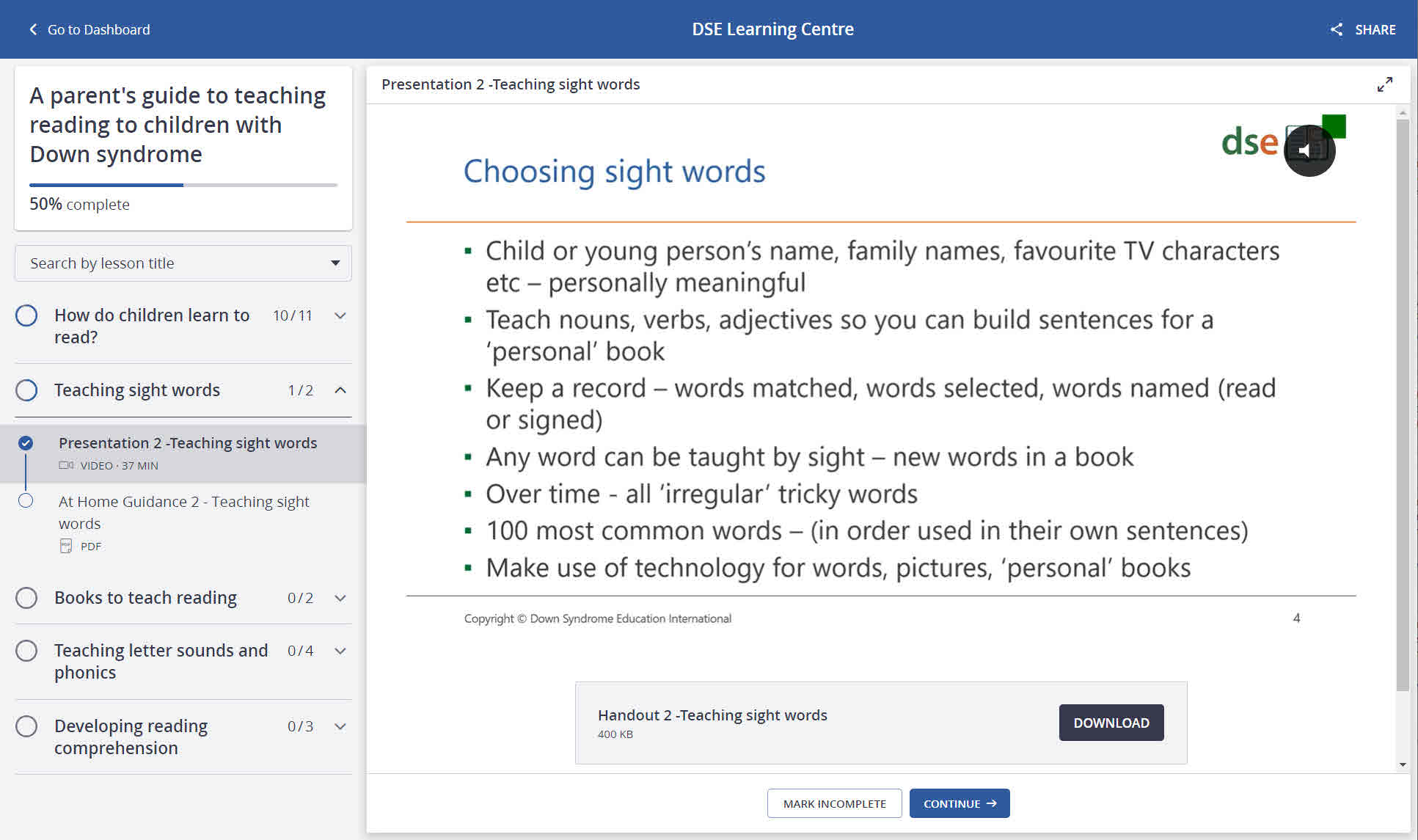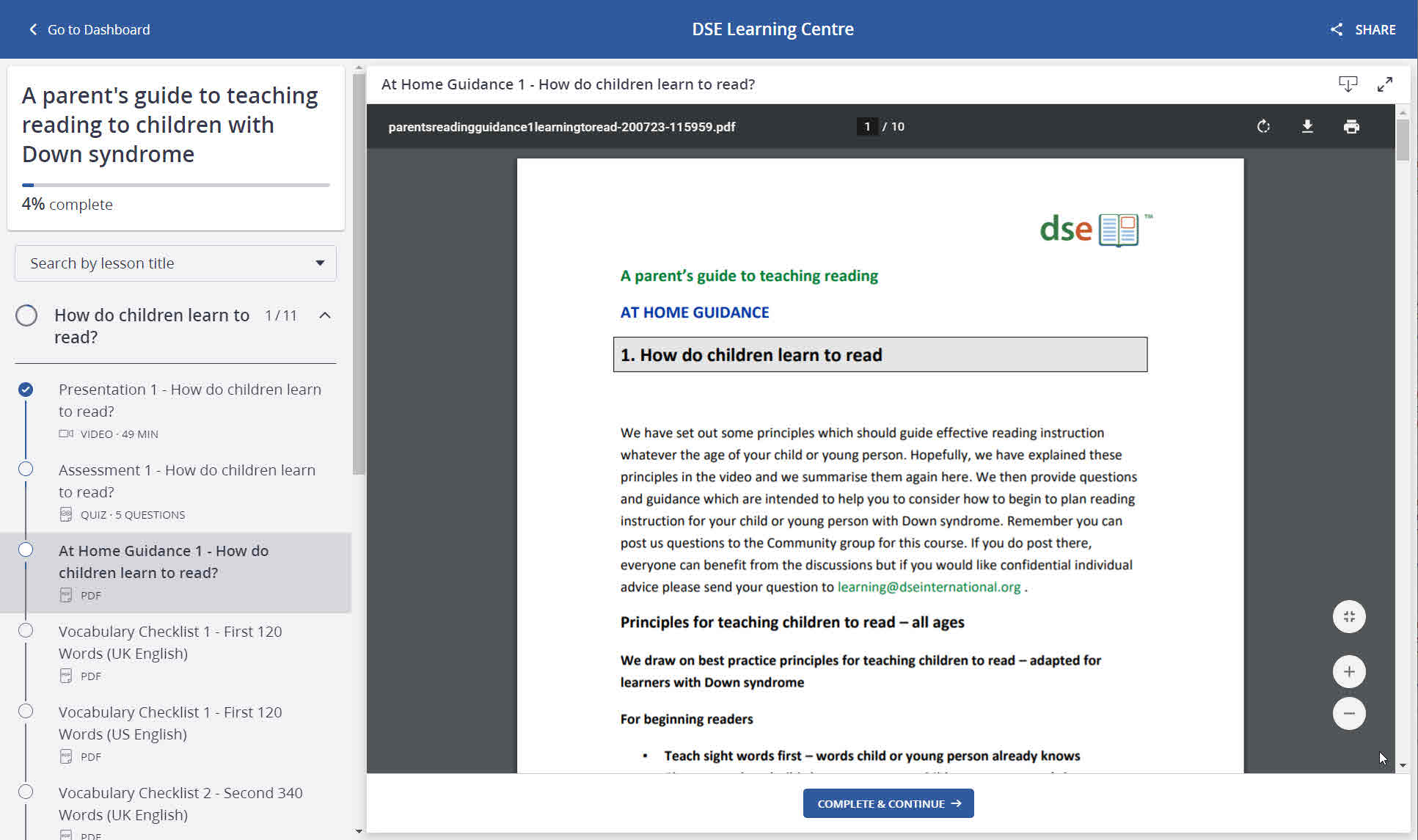A parent's guide to teaching reading to children and young people with Down syndrome
This online course offers detailed, practical guidance and support to help families teach children and young people with Down syndrome to read.
On this page:
The aim of this course is to help parents to teach their children and young people to read. Many individuals with Down syndrome do not get reading instruction in school and we know that many have been taught to read by their parents. If they are getting reading instruction in school, research tells us that the support all children receive at home influences their reading progress. The course aims to give parents the information and confidence they need to support their children's reading progress. Recent reviews estimate that some 80% of children with Down syndrome can develop useful levels of reading abilities and that progress can be made in early adult years. We take account of the individual differences in progress and describe the benefits of supported reading for all children. We also explain how to use reading activities to develop spoken language for all children and young people even if they have limited independent reading ability.

Presented and led by Professor Sue Buckley OBE, this course includes five modules. Each module includes a 40- 50 minute video presentation which sets out the key information on the topic, and At Home Guidance which sets out the principles for effective teaching, how to apply the video information and design practical activities for an individual child or young person, from beginners to more advanced readers. Activities are designed to be easily implemented at home and links to recommended resources are provided.
The course sets out the principles for teaching reading which can be applied from 3 years of age, through school years and in early adult years. While the course contains five modules which can be completed in five weeks, the content and materials will support a young person's reading development over many years.

Contents
The following modules are included in this course:
- How do children learn to read? - This module explains how children learn to read and how it depends on two independent processes - word reading and language comprehension. It explains how word reading involves both sight word learning and decoding using letter sounds while fully understanding the text depends on language comprehension. Children can have differing profiles of strengths and weaknesses for both these processes which affect their reading progress. It presents what we know about how children with Down syndrome learn to read, the factors which may influence their progress and how we adapt teaching to meet their needs. It ends with a summary of the principles which should inform balanced reading instruction.
- Teaching sight words - This module focusses on how to teach sight words. All beginning readers start by learning sight words and continue to learn many words by sight as they have irregular spellings. The module provides guidance on how to choose sight words, how to teach them using matching, selecting and naming techniques and errorless learning approaches to support success. Words are chosen to build sentences at the child or young person's language level and make simple books. It explains the importance of ensuring children understand the words and sentences that they read from the outset and practical ways to do this.
- Books to teach reading - This module focusses on how choose or make books to teach reading. It explains the value of making 'personal' books for children, teens and young adults and how they support reading progress and comprehension. It gives guidance on choosing published books and reading schemes. It explains how to teach a new book and to combine book reading instruction with sight word teaching in a lesson. It explains how to monitor reading progress and understand a young person's reading strategies as they read. It discusses the options of using apps and software to make books and teach reading. Course participants are encouraged to complete these first three modules before they start to teach their young person to read.
- Teaching letter sounds and phonics - This module focuses on how to teach children and young people to decode new words in text using letter sound knowledge. It explains that there are three steps to be mastered, learning the letter - sound correspondences, being able to hear sounds in spoken words (phonological awareness) and then learn how letters and sounds work in printed words. Once children reach this point, they can 'self-teach' by sounding out and blending the sounds to work out a word - provided it is a word they already know in their spoken language. Guidance is given on linking learning about decoding to words children can read and are learning in their books as well as using adapted teaching with extra visual supports developed for children with Down syndrome.
- Developing reading comprehension - This module provides guidance on how to ensure children understand what they read. We know that fully understanding what they read can be a challenge for young people with Down syndrome as they have delayed language and delayed working memory and both influence reading comprehension. The module provides guidance on how to support comprehension including teaching a number of strategies to young people which show them how to fully understand what they read. In addition, it discusses the role of developing language in improving reading comprehension and how to increase learning from life experiences so that young people are able to draw on their own world knowledge to help them understand text.



Features
This course features:
- Video presentations - lasting between 30 and 40 minutes, available to course participants for streaming on-demand
- Handouts - download copies of the slides in the presentation to work through
- 'At Home' Guidance - to help you consider how the information we have discussed in the presentations applies to your baby, child or young person with Down syndrome
- DSE Language Records - for tracking children's progress and selecting teaching targets
- Certificate of achievement - certificate for participants who successfully complete the course
Course duration
The course requires a minimum of 20 hours of study in order to complete the practical activities for each module.
Access to the course is available as a monthly subscription or a single purchase of 12 months.
How to book
You can purchase access to our online courses via our subscriptions website .
Help with online courses and subscriptions
Please visit our support site for additional help with online courses and subscriptions.

